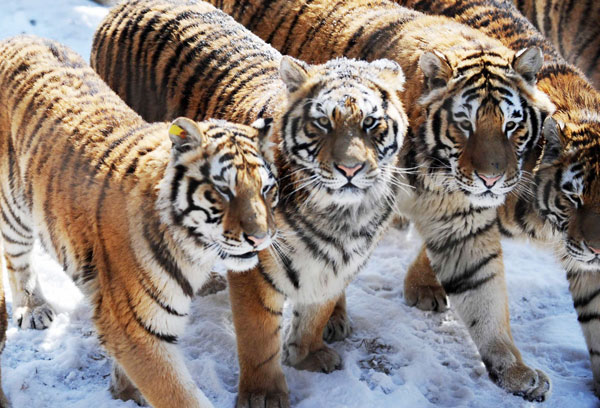Two more reserves for Siberian tigers
Updated: 2013-04-05 01:30
By WU YONG in Vladivostok, Russia (China Daily)
|
||||||||
China will set up two more national reserves for Siberian tigers in Jilin and Heilongjiang provinces to protect the endangered species, said an official from the Feline Research Center of the State Forestry Administration on Thursday.
The two reserves will be in Wangqing in Jilin, and Laoyeling in Heilongjiang, said Jiang Guangshun, deputy head of the center.
Siberian tigers mainly inhabit northeastern China, Russia's Far East region, and the Korean Peninsula. Currently, the number of wild Siberian tigers in the world is estimated at around 500.
 |
| Several tigers walk in a reserve in Harbin, Heilongjiang province on March 22, 2013. [Photo/Xinhua] |
China established its first national reserve for Siberian tigers in 2001 in Hunchun, Jilin province, which borders Russia and the Democratic People's Republic of Korea.
Jiang Jinsong, an official from Jilin provincial forestry department, said the province's efforts to protect the big cats had paid off. The number of Siberian tigers living in northeastern China has risen to around 20, from just five in the 1990s.
Both of the officials were attending an annual meeting on the protection of wild Siberian tigers being held in the Russian city of Vladivostok.
Yuri Darman, director of the World Wide Fund for Nature (WWF) Amur Branch, praised China for its contribution to the protection of Siberian tigers. "We hope to deepen our cooperation in this field," he said.
However, experts said the work to protect the big cats remains difficult due to a shortage of capital, technology and professionals at the grassroots level.
Jiang Guangshun said he hoped that the central government would establish an office at the national level to supervise protection work across the country.
Moreover, he said that Heilongjiang will sign an agreement with Russia's Primorsky Krai on wild Amur leopard protection this year. "Our cooperation will expand from protection of Siberian tigers to Amur leopards," he said.
The Amur leopard, living in northeastern China and Russia's Far East region, is a subspecies of the Panthera genus. The WWF said there are only around 50 in the wild, making it one of the most endangered species in the world.
Liu Ce in Shenyang contributed to the story
wuyong@chinadaily.com.cn

 Li Na on Time cover, makes influential 100 list
Li Na on Time cover, makes influential 100 list
 FBI releases photos of 2 Boston bombings suspects
FBI releases photos of 2 Boston bombings suspects
 World's wackiest hairstyles
World's wackiest hairstyles
 Sandstorms strike Northwest China
Sandstorms strike Northwest China
 Never-seen photos of Madonna on display
Never-seen photos of Madonna on display
 H7N9 outbreak linked to waterfowl migration
H7N9 outbreak linked to waterfowl migration
 Dozens feared dead in Texas plant blast
Dozens feared dead in Texas plant blast
 Venezuelan court rules out manual votes counting
Venezuelan court rules out manual votes counting
Most Viewed
Editor's Picks

|

|

|

|

|

|
Today's Top News
Boston bombing suspect reported cornered on boat
7.0-magnitude quake hits Sichuan
Cross-talk artist helps to spread the word
'Green' awareness levels drop in Beijing
Palace Museum spruces up
First couple on Time's list of most influential
H7N9 flu transmission studied
Trading channels 'need to broaden'
US Weekly

|

|







